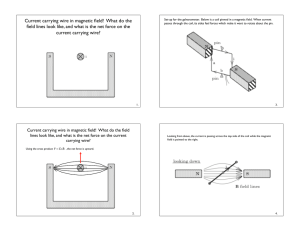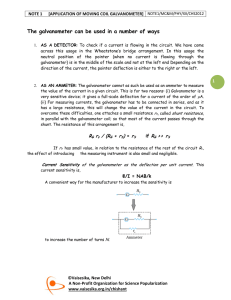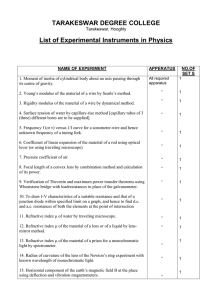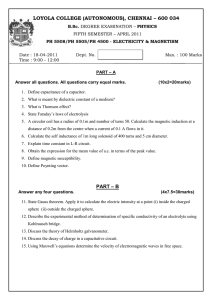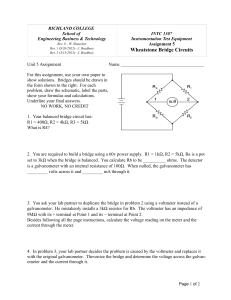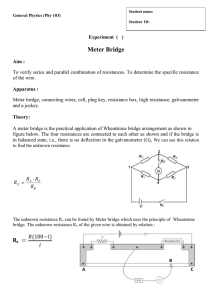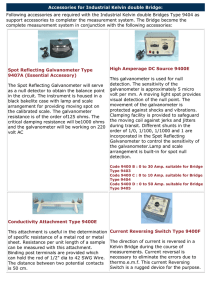Conversion of Galvanometer to Ammeter
advertisement
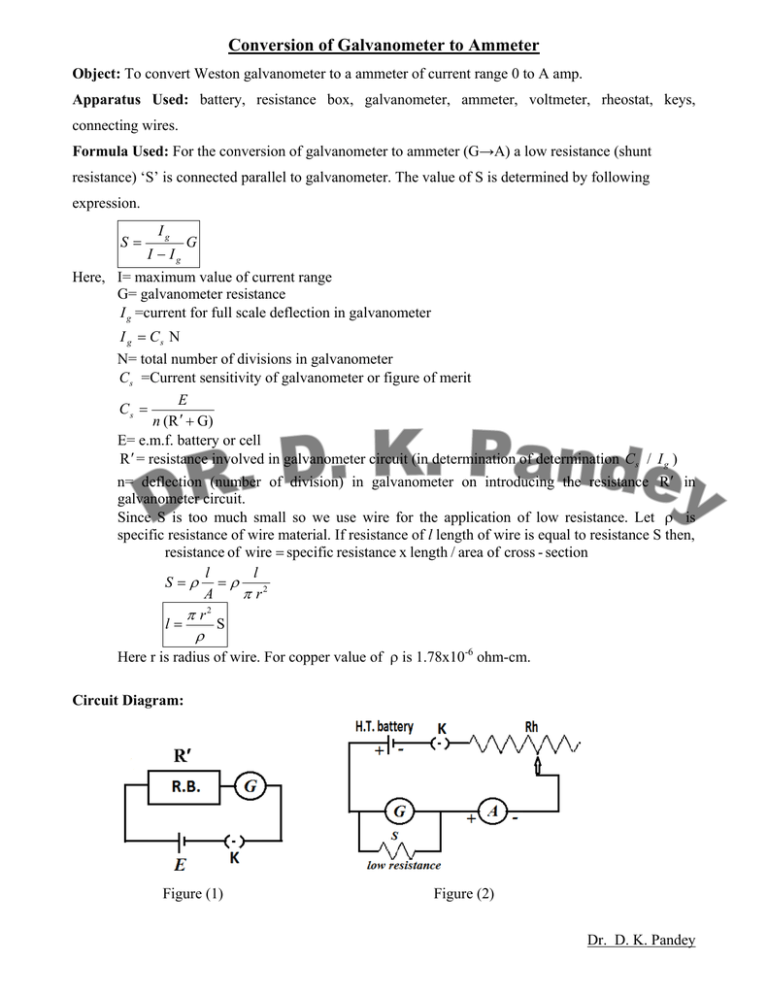
Conversion of Galvanometer to Ammeter Object: To convert Weston galvanometer to a ammeter of current range 0 to A amp. Apparatus Used: battery, resistance box, galvanometer, ammeter, voltmeter, rheostat, keys, connecting wires. Formula Used: For the conversion of galvanometer to ammeter (G→A) a low resistance (shunt resistance) ‘S’ is connected parallel to galvanometer. The value of S is determined by following expression. S= Ig I − Ig G Here, I= maximum value of current range G= galvanometer resistance I g =current for full scale deflection in galvanometer I g = Cs N N= total number of divisions in galvanometer Cs =Current sensitivity of galvanometer or figure of merit E Cs = n (R ′ + G) E= e.m.f. battery or cell R ′ = resistance involved in galvanometer circuit (in determination of determination Cs / I g ) n= deflection (number of division) in galvanometer on introducing the resistance R ′ in galvanometer circuit. Since S is too much small so we use wire for the application of low resistance. Let ρ is specific resistance of wire material. If resistance of l length of wire is equal to resistance S then, resistance of wire = specific resistance x length / area of cross - section l l S=ρ =ρ A π r2 π r2 l= S ρ Here r is radius of wire. For copper value of ρ is 1.78x10-6 ohm-cm. Circuit Diagram: Figure (1) Figure (2) Dr. D. K. Pandey Procedure: 1. Measure the e.m.f. of given cell/battery (E). Read the value of G written in galvanometer and total number of division (N) in galvanometer. 2. Make connections as shown in Figure (1). 3. Now close the key K . Note the value of deflection in galvanometer (n ) with varying the resistance in resistance box ( R ′ ). 4. Calculate the value of Cs for all set of R ′ and n using E and G. Now determine I g with expression I g = C s N and find the mean value of it. 5. See in galvanometer, a value of current is written this is I g . If your calculated I g is approximately same with this value then observation up to this point is correct. If it is not true then repeat/check the process 3→4. 6. After it, calculate the value of S with the formula given in formula used. Further determine the length of copper wire equivalent to resistance S, by measuring the radius of wire 7. Now make the circuit diagram as shown in figure (2). Vary the deflection in galvanometer from 2→30 divisions in interval of 2 with help of rheostat and note the corresponding ammeter readings (I). 8. If A is maximum current of given current range then current equal to one division on galvanometer is A/N. Using it convert galvanometer deflections in current ( I ′ ). 9. Now calculate the difference of I and I′ . If value of I and I ′ are approximately same or their difference is too much small then the conversion of G→A is correct. Observation: 1. E= ……..volt 2. G= ……..Ω 3. N= …….. 4. Table for I g Sr.No. R ′ (Ω) n Cs 5000 6000 7000 8000 9000 10000 5. Calibration of shunted galvanometer Sr.No. Galvanometer reading In division In amp ( I′ ) I g (A) mean I g (in A or µA) 1. 2. 3. 4. 5. 6. ammeter reading I ( in amp) Error ( I′ -I) (in amp) Calculation: Show all calculations of Cs , I g and S. Result: The length of shunt wire required to convert the given galvanometer in to ammeter of range of …………..….. amp is ……………..……cm. Precautions: 1. Resistance in determination of figure of merit should be of high value. 2. Exact length of wire should be connected parallel to galvanometer. 3. Ammeter should be connected using sign convention. 4. Ammeter used in calibration of shunted galvanometer should be of nearly same range. 5. In calibration process the readings should be noted from zero. Dr. D. K. Pandey

